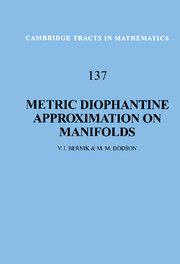Book contents
- Frontmatter
- Contents
- Preface
- Notation
- Chapter 1 Diophantine approximation and manifolds
- Chapter 2 Khintchine's and Groshev's theorems for manifolds
- Chapter 3 Hausdorff measure and dimension
- Chapter 4 Upper bounds for Hausdorff dimension
- Chapter 5 Lower bounds for Hausdorff dimension
- Chapter 6 Diophantine approximation over the p-adic field
- Chapter 7 Applications
- References
- Index
Chapter 3 - Hausdorff measure and dimension
Published online by Cambridge University Press: 04 August 2010
- Frontmatter
- Contents
- Preface
- Notation
- Chapter 1 Diophantine approximation and manifolds
- Chapter 2 Khintchine's and Groshev's theorems for manifolds
- Chapter 3 Hausdorff measure and dimension
- Chapter 4 Upper bounds for Hausdorff dimension
- Chapter 5 Lower bounds for Hausdorff dimension
- Chapter 6 Diophantine approximation over the p-adic field
- Chapter 7 Applications
- References
- Index
Summary
Introduction
Hausdorff measure and dimension stem from F. Hausdorff's simple but farreaching variation of C. Carathéodory's approach to Lebesgue measure (more details are given in the Notes at the end of the chapter). For familiar sets such as the interval, circle, sphere and the plane, the Hausdorff dimension (defined below in §3.3) coincides with the usual notion of dimension and is respectively 1,1,2 and 2. However, an important difference is that any set in Euclidean space has a Hausdorff dimension. In particular, null sets have a Hausdorff dimension and this gives a way of discriminating between them. The study of this finer aspect of the metric structure of exceptional sets, which started with Hausdorff's determination of the dimension of the Cantor ‘middle third’ set, was developed by A. S. Besicovitch and V. Jarník and continues unabated.
Hausdorff measure has been studied intensively and in considerable generality, indeed the theory can be extended to a metric space setting. This tract will be concerned mainly with Borel subsets of submanifolds of Euclidean space and accordingly the treatment of Hausdorff measure and dimension will be in ℝn. Fuller treatments and further references can be found in the books of K. Falconer, H. Federer, P. Mattila and C. A. Rogers. Applications to exceptional sets in number theory are discussed in.
Hausdorff measure
Hausdorff measure is based on covers. Let E be a set in ℝn and let s be a non-negative real number.
- Type
- Chapter
- Information
- Metric Diophantine Approximation on Manifolds , pp. 58 - 76Publisher: Cambridge University PressPrint publication year: 1999



